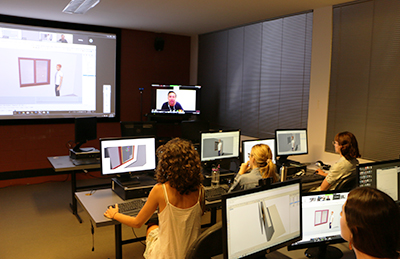NIDA technology specialists deploy interactive video technology to connect a leading design professional with third year BFA Design students.

Our third year Bachelor of Fine Arts (Design for Performance) students are currently undertaking a five-week program of training sessions in a ‘virtual classroom’, led by one of the world’s leading film and television designers Andrew Chan.
The technology has been set-up at NIDA’s Kensington campus and enables Chan to train NIDA students on a 3D modelling program used for set and film design, while at the same time remaining in New Zealand where he is working with a renowned director as Art Director on a high-profile film.
‘Andrew Chan brings the highest professional expertise in Rhino and digital technologies. As he is working in New Zealand with a prominent director, he is connected to the most cutting-edge technology and its developments and design thinking. By being able to connect to him while he works in a different country, he is able to share his experiences first hand,’ commented Julie Lynch, NIDA’s Acting Head of Design for Performance.
‘Without the expertise of NIDA technology, our design students would have missed out on this unique opportunity. This scenario goes far beyond a teacher presenting via Skype; this set up is completely interactive and is the future of education. It enables NIDA to access the best artists and practitioners across the globe and bring them into the classroom remotely,’ added Lynch.
NIDA Technical Project Specialist Aymeric Dhillon and his team were responsible for implementing and fine-tuning the technology to bring Chan to NIDA without him ever having to leave New Zealand, utilising established video linking platform services combined with in-house custom use of Open Source software plugins.
Key to the system is its augmented interactivity.
‘Essentially we’re emulating Andrew’s presence here in the classroom beyond the familiar video conference style “talking head” image, while also bringing the whole class and each student’s individual work in the lesson direct to Andrew’s screen at his location,’ said Dhillon. ‘And to achieve this effectively the technology platform must enable a sense of telepresence for the trainer and the class, taking interactivity as we experience it currently and moving a step closer towards a live and real time collaboration environment.’
The set up in NIDA’s Computer Lab classroom enables the class to follow Andrews’s lead by watching his demonstrations on a large projection screen. For finer details, which is often required when working with 3D creation tools, each student has two monitors at their desk, the second showing them the close up detail view off the trainer’s screen live.
According to Dhillon, the telepresence aspect allows Andrew to see and hear the class throughout the lesson, while the students also see a big close up of Andrew on another large screen, which is positioned beside the projection screen.
‘Everyone can talk freely at any time and the trainer and class can always see each other, call out for help or chat, in addition to simultaneously viewing the work they are doing on their PC’s,’ he said. ‘Cameras and microphones are positioned to optimise the sense of eye contact and proximity. The feedback from students and Andrew is that they feel like they are together in the room.’
‘If Andrew notices on his monitor that a student needs extra assistance in a group exercise, he can click on his view of their PC, make it full screen at his end and take control of the student’s mouse and keyboard to show them the way forward directly on the students PC. If this is of interest to the whole class, he can use that student’s example and demonstrate this by sharing the student’s desktop on the large projection screen. This works just as well the other way around, if a student has a question, they can just ask Andrew as if he was in the room. The trainer can then help them individually by guiding them and watching their actions or they can take over and demonstrate just to them or the whole class.’
‘I believe it’s definitely one of the best set-ups for learning this program,’ commented former BFA (Design for Performance) graduate Gabrielle Rowe, who is now a MFA (Design for Performance) student and is assisting with the classes, using her experience of the course to help guide students.
For more information on studying design at NIDA, visit BFA (Design for Performance) or MFA (Design for Performance).
